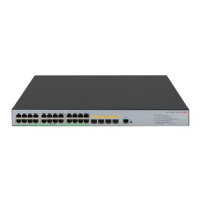150
Enabling PIM-DM globally on the public network
Ste
Command Remarks
1. Enter system view.
system-view N/A
2. Enable IP multicast routing.
multicast routing-enable Disabled by default.
3. Enter interface view.
interface interface-type
interface-number
N/A
4. Enable PIM-DM.
pim dm Disabled by default.
Enabling PIM-DM in a VPN instance
Ste
Command Descri
tion
1. Enter system view.
system-view N/A
2. Create a VPN instance and
enter VPN instance view.
ip vpn-instance vpn-instance-name
N/A
3. Configure an RD for the VPN
instance.
route-distinguisher
route-distinguisher
Not configured by default.
4. Enable IP multicast routing.
multicast routing-enable Disabled by default.
5. Enter interface view.
interface interface-type
interface-number
N/A
6. Bind the interface with a VPN
instance.
ip binding vpn-instance
vpn-instance-name
By default, an interface belongs to
the public network, and is not
bound with any VPN instance.
7. Enable PIM-DM.
pim dm Disabled by default.
For more information about the ip vpn-instance, route-distinguisher, and ip binding vpn-instance
commands, see IP Routing Command Referenc
e.
For more information about the multicast routing-enable command, see IP Multicast Command
Reference.
Enabling state-refresh capability
Pruned interfaces resume multicast forwarding when the pruned state times out. To prevent this, the router
with the multicast source attached periodically sends an (S, G) state-refresh message, which is forwarded
hop by hop along the initial multicast flooding path of the PIM-DM domain, to refresh the prune timer
state of all the routers on the path. A multi-access subnet can have the state-refresh capability only if the
state-refresh capability is enabled on all PIM routers on the subnet.
To enable the state-refresh capability:
Ste
Command Remarks
1. Enter system view.
system-view N/A

